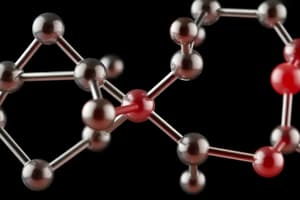Podcast
Questions and Answers
Which of the following are hybridizations of orbitals?
Which of the following are hybridizations of orbitals?
- sp
- sp2
- sp3
- All of the above (correct)
What are some examples of non-covalent interactions?
What are some examples of non-covalent interactions?
- Van der Waals interactions (correct)
- Cation-π interactions (correct)
- Hydrogen bonds (correct)
- Covalent bonds
What is a nucleophile?
What is a nucleophile?
An electron-rich group which is either negatively charged or contains unshared electron pairs.
What is an electrophile?
What is an electrophile?
Which amines are considered most nucleophilic?
Which amines are considered most nucleophilic?
What condition affects the protonation of amines in biological pH?
What condition affects the protonation of amines in biological pH?
Match the following terms with their definitions:
Match the following terms with their definitions:
Flashcards are hidden until you start studying
Study Notes
General Chemistry
-
VSEPR (Valence Shell Electron Pair Repulsion) Theory determines local geometries around atoms in molecules by predicting shapes based on electron pairs.
-
Common orbital hybridizations include:
- sp: linear geometry
- sp2: trigonal planar geometry
- sp3: tetrahedral geometry
- sp3d: trigonal bipyramidal geometry
- sp3d2: octahedral geometry
-
Electronegativity varies among elements in the periodic table, impacting bond polarity and molecular stability.
-
Non-covalent interactions play crucial roles in molecular biology, including:
- Hydrogen bonds: important for DNA and protein structure
- Van der Waals interactions: weak forces that contribute to molecular interactions
- Cation-π interactions: involve positively charged ions interacting with electron-rich pi systems
-
Resonance structures illustrate multiple ways of representing electron distribution in molecules, influenced by electronegativity. Examples include:
- Carbonyl group
- Carboxylate group
- Amide bond
-
Oxidation states in organic molecules depend on relative electronegativities, guiding the understanding of redox reactions.
Organic Chemistry
-
Nucleophiles are electron-rich species that donate electrons to electron-deficient groups (electrophiles). They can be negatively charged or possess lone pairs.
-
Electrophiles are electron-deficient species attracted to nucleophiles. They may be positively charged or feature an incomplete valence shell, enhancing their electron-accepting nature.
-
Lone pairs refer to pairs of electrons localized on one atom, contributing to the reactivity and bonding characteristics of molecules.
-
Leaving groups are atoms or groups that are expelled during substitution or displacement reactions. These groups should be stable upon departure.
-
Amines serve as nucleophiles in their free base form, with primary amines being the most nucleophilic, followed by secondary and tertiary amines, which face steric hindrance.
- Typical pKa of ammonium is around 9-10; at physiological pH (~7.0), most amines exist as protonated ammonium salts.
- N-H bonds are highly polar, and nitrogen's lone pairs form hydrogen bonds, influencing solubility and reactivity.
-
Example Reactions:
- Ethylamine Hydrochloride: a primary amine that is both basic and nucleophilic.
- Tris Hydrochloride: a tertiary amine that is basic but not nucleophilic due to steric hindrance.
Studying That Suits You
Use AI to generate personalized quizzes and flashcards to suit your learning preferences.




